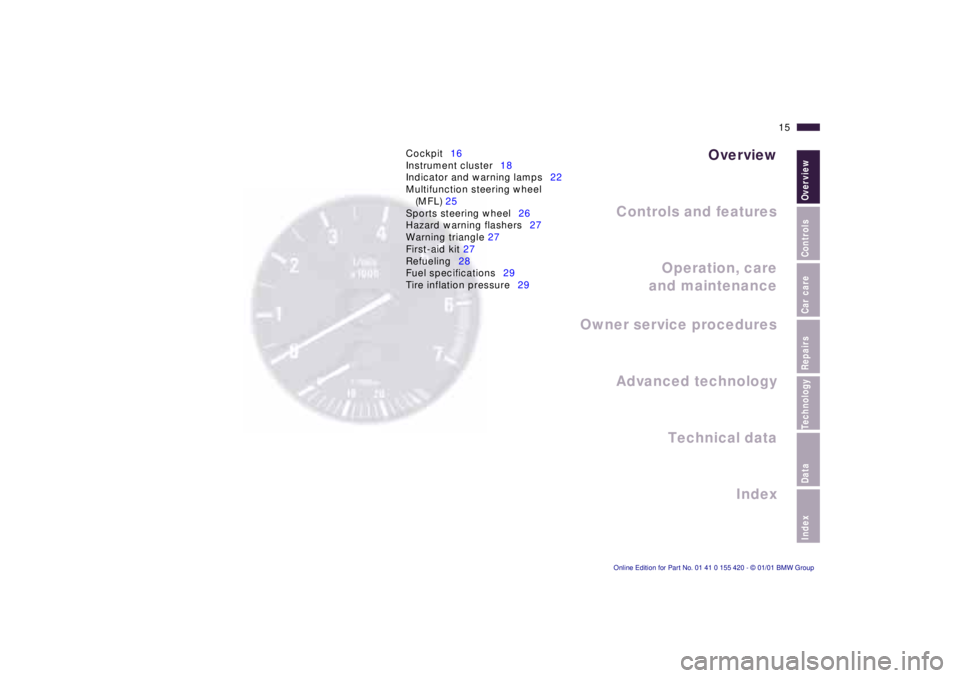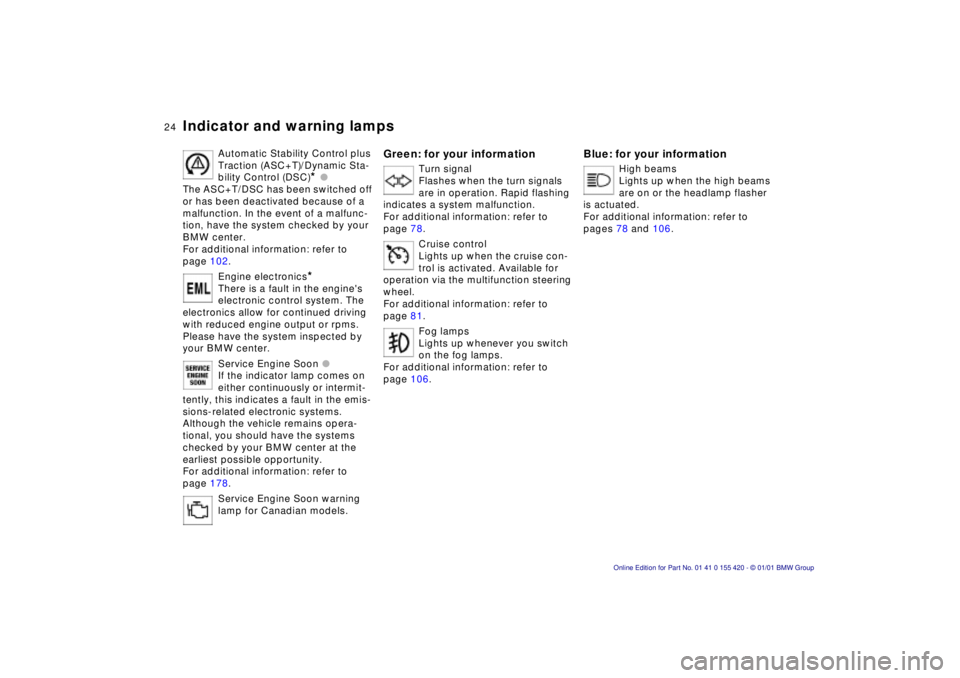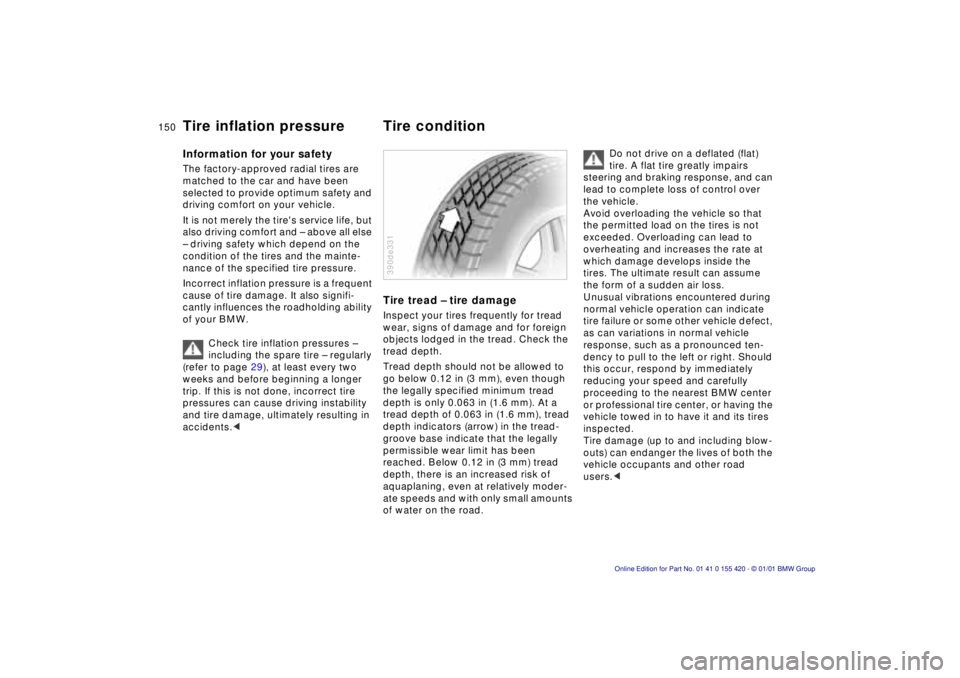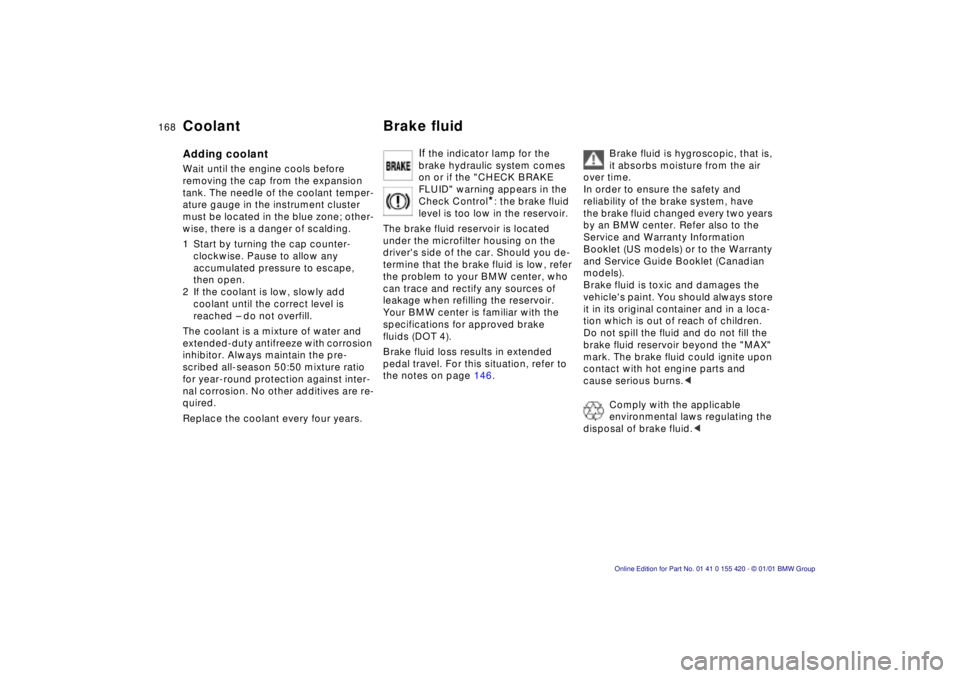2001 BMW 540I SEDAN service indicator
[x] Cancel search: service indicatorPage 10 of 238

Contents
Overview
Controls and features
Cockpit16
Instrument cluster18
Indicator and warning lamps22
Multifunction steering wheel
(MFL) 25
Sports steering wheel26
Hazard warning flashers27
Warning triangle 27
First-aid kit 27
Refueling28
Fuel specifications29
Tire inflation pressure29
Locks and security systems:
Keys36
Electronic vehicle
immobilizer37
Opening and closing –
from the outside38
With the key38
With the remote control39
Opening and closing –
from the inside42
Luggage compartment lid/
Tailgate43
Rear window43
Luggage compartment46
Alarm system47
Electric power windows49
Sliding/Tilt sunroof50
Adjustments:
Seats52
Steering wheel56
Mirrors56
Seat, mirror and steering wheel
memory58
Car Memory, Key Memory60
Passenger safety systems:
Safety belts61
Airbags62
Transporting children safely66
Driving:
Steering/Ignition lock68
Starting the engine68
Switching off the engine69
Parking brake70
Manual transmission70
Automatic transmission72
Automatic transmission with
Steptronic75
Indicator/Headlamp flasher78
Wiper/Washer system78
Rear window defroster80
Cruise control81
Everything under control:
Odometer, outside temperature
display83
Tachometer84
Energy control84
Fuel gauge84
Coolant temperature gauge85
Service Interval Display85
Check Control86
Computer89
Multi-information display
(MID)91
Digital clock in the MID92
Computer in the MID95
Page 15 of 238

IndexDataTechnologyRepairsCar careControlsOverview
Overview
Controls and features
Operation, care
and maintenance
Owner service procedures
Technical data
Index Advanced technology
15n
Cockpit16
Instrument cluster18
Indicator and warning lamps22
Multifunction steering wheel
(MFL) 25
Sports steering wheel26
Hazard warning flashers27
Warning triangle 27
First-aid kit 27
Refueling28
Fuel specifications29
Tire inflation pressure29
Page 19 of 238

IndexDataTechnologyRepairsCar careControlsOverview
19n
Instrument cluster
There are two versions, depending on
the equipment on your vehicle.
1 Fuel gauge with indicator lamp for
fuel reserve84
2 Indicator lamp for turn signals24
3 Speedometer
4 Indicator lamp for high beams24
5 Tachometer and
Energy Control84
6 Coolant thermometer with
"Coolant temperature too high"
warning lamp85
7 Indicator and warning lamps for:
>
Parking brake/Brake hydraulic
system, Dynamic Brake Control
(DBC)
*
22, 23
>
Antilock Brake System (ABS)23
>
Brake pads23
>
Tire Pressure Control (RDC)
*
23
>
Airbags23
>
Automatic transmission
*
23
>
Please fasten safety belts23
>
Cruise control24
8 Selector lever and program display
for automatic transmission
*
72, 75
9 Service Interval Display8510 Display for the computer
(operation via the turn signal lever,
refer to page 89):
>
Outside temperature
>
Average fuel consumption
>
Cruising range
>
Average speed
11 Indicator lamp for Automatic
Stability Control plus Traction
(ASC+T)/Dynamic Stability
Control (DSC)
*
24
12 Indicator lamp for level control
system
*
23
13 Odometer and trip odometer83
14 Indicator for Check Control86
15 Reset button for trip odometer83
16 Indicator and warning lamps for:
>
Fog lamps24
>
Battery charge current22
>
Engine oil level/Engine oil
pressure22, 23
>
Engine electronics24
>
Service Engine Soon24
Page 21 of 238

IndexDataTechnologyRepairsCar careControlsOverview
21n
Instrument cluster
*
There are two versions, depending on
the equipment on your vehicle.
1 Fuel gauge with indicator lamp for
fuel reserve84
2 Indicator lamp for turn signals24
3 Speedometer
4 Indicator lamp for high beams24
5 Tachometer and
Energy control84
6 Coolant temperature gauge85
7 Indicator and warning lamps for:
>
Parking brake 23
>
Brake hydraulic system, Dynamic
Brake Control (DBC)
*
22, 23
>
Antilock Brake System (ABS)23
>
Airbags23
>
Please fasten safety belts23
>
Cruise control24
8 CHECK button86
9 Selector lever and program display
for automatic transmission
*
72, 7510 Outside temperature display83
11 Indicator lamp for Automatic
Stability Control plus Traction
(ASC+T)/Dynamic Stability
Control (DSC)
*
24
12 Trip odometer83
13 Check Control display86
14 Odometer83
15 Service Interval Display85
16 Reset button for trip odometer83
17 Indicator and warning lamps for:
>
Fog lamps24
>
Battery charge current22
>
Engine oil pressure22
>Service Engine Soon24
Page 24 of 238

24n
Indicator and warning lamps
Automatic Stability Control plus
Traction (ASC+T)/Dynamic Sta-
bility Control (DSC)
* l
The ASC+T/DSC has been switched off
or has been deactivated because of a
malfunction. In the event of a malfunc-
tion, have the system checked by your
BMW center.
For additional information: refer to
page 102.
Engine electronics
*
There is a fault in the engine's
electronic control system. The
electronics allow for continued driving
with reduced engine output or rpms.
Please have the system inspected by
your BMW center.
Service Engine Soon l
If the indicator lamp comes on
either continuously or intermit-
tently, this indicates a fault in the emis-
sions-related electronic systems.
Although the vehicle remains opera-
tional, you should have the systems
checked by your BMW center at the
earliest possible opportunity.
For additional information: refer to
page 178.
Service Engine Soon warning
lamp for Canadian models.
Green: for your information
Turn signal
Flashes when the turn signals
are in operation. Rapid flashing
indicates a system malfunction.
For additional information: refer to
page 78.
Cruise control
Lights up when the cruise con-
trol is activated. Available for
operation via the multifunction steering
wheel.
For additional information: refer to
page 81.
Fog lamps
Lights up whenever you switch
on the fog lamps.
For additional information: refer to
page 106.
Blue: for your information
High beams
Lights up when the high beams
are on or the headlamp flasher
is actuated.
For additional information: refer to
pages 78 and 106.
Page 34 of 238

34n
Locks and security systems:
Keys 36
Electronic vehicle immobilizer 37
Central locking system 38
Opening and closing –
from the outside 38
With the key 38
With the remote control 38
Opening and closing – from the inside 42
Luggage compartment lid/ Tailgate 43
Rear window 44
Luggage compartment 46
Alarm system 47
Electric power windows 49
Sliding/Tilt sunroof 50
Adjustments:
Seats 52
Steering wheel 56
Mirrors 56
Seat, mirror and steering wheel memory 58
Car Memory, Key Memory 60
Passenger safety systems:
Safety belts 61
Airbags 62
Transporting children safely 66Driving:
Steering/Ignition lock
68
Starting the engine 68
Switching off the engine 69
Parking brake 70
Manual transmission 70
Automatic transmission 72
Automatic transmission with Steptronic 75
Indicator/Headlamp flasher 78
Wiper/Washer system 78
Rear window defroster 80
Cruise control 81
Everything under control:
Odometer, outside temperature display 83
Tachometer 84
Energy control 84
Fuel gauge 84
Coolant temperature gauge 85
Service Interval Display 85
Check Control 86
Computer 89
Multi-information display (MID) 91
Digital clock in the MID 92
Computer in the MID 95
Page 150 of 238

150n
Information for your safety
The factory-approved radial tires are
matched to the car and have been
selected to provide optimum safety and
driving comfort on your vehicle.
It is not merely the tire's service life, but
also driving comfort and – above all else
– driving safety which depend on the
condition of the tires and the mainte-
nance of the specified tire pressure.
Incorrect inflation pressure is a frequent
cause of tire damage. It also signifi-
cantly influences the roadholding ability
of your BMW.
Check tire inflation pressures –
including the spare tire – regularly
(refer to page 29), at least every two
weeks and before beginning a longer
trip. If this is not done, incorrect tire
pressures can cause driving instability
and tire damage, ultimately resulting in
accidents. <
Tire tread – tire damage
Inspect your tires frequently for tread
wear, signs of damage and for foreign
objects lodged in the tread. Check the
tread depth.
Tread depth should not be allowed to
go below 0.12 in (3 mm), even though
the legally specified minimum tread
depth is only 0.063 in (1.6 mm). At a
tread depth of 0.063 in (1.6 mm), tread
depth indicators (arrow) in the tread-
groove base indicate that the legally
permissible wear limit has been
reached. Below 0.12 in (3 mm) tread
depth, there is an increased risk of
aquaplaning, even at relatively moder-
ate speeds and with only small amounts
of water on the road.
390de331
Do not drive on a deflated (flat)
tire. A flat tire greatly impairs
steering and braking response, and can
lead to complete loss of control over
the vehicle.
Avoid overloading the vehicle so that
the permitted load on the tires is not
exceeded. Overloading can lead to
overheating and increases the rate at
which damage develops inside the
tires. The ultimate result can assume
the form of a sudden air loss.
Unusual vibrations encountered during
normal vehicle operation can indicate
tire failure or some other vehicle defect,
as can variations in normal vehicle
response, such as a pronounced ten-
dency to pull to the left or right. Should
this occur, respond by immediately
reducing your speed and carefully
proceeding to the nearest BMW center
or professional tire center, or having the
vehicle towed in to have it and its tires
inspected.
Tire damage (up to and including blow-
outs) can endanger the lives of both the
vehicle occupants and other road
users. <
Tire inflation pressure Tire condition
Page 168 of 238

168nCoolant Brake fluid
Adding coolant
Wait until the engine cools before
removing the cap from the expansion
tank. The needle of the coolant temper-
ature gauge in the instrument cluster
must be located in the blue zone; other-
wise, there is a danger of scalding.
1 Start by turning the cap counter-
clockwise. Pause to allow any
accumulated pressure to escape,
then open.
2 If the coolant is low, slowly add coolant until the correct level is
reached – do not overfill.
The coolant is a mixture of water and
extended-duty antifreeze with corrosion
inhibitor. Always maintain the pre-
scribed all-season 50:50 mixture ratio
for year-round protection against inter-
nal corrosion. No other additives are re-
quired.
Replace the coolant every four years.
If the indicator lamp for the
brake hydraulic system comes
on or if the "CHECK BRAKE
FLUID" warning appears in the
Check Control
*: the brake fluid
level is too low in the reservoir.
The brake fluid reservoir is located
under the microfilter housing on the
driver's side of the car. Should you de-
termine that the brake fluid is low, refer
the problem to your BMW center, who
can trace and rectify any sources of
leakage when refilling the reservoir.
Your BMW center is familiar with the
specifications for approved brake
fluids (DOT 4).
Brake fluid loss results in extended
pedal travel. For this situation, refer to
the notes on page 146.
Brake fluid is hygroscopic, that is,
it absorbs moisture from the air
over time.
In order to ensure the safety and
reliability of the brake system, have
the brake fluid changed every two years
by an BMW center. Refer also to the
Service and Warranty Information
Booklet (US models) or to the Warranty
and Service Guide Booklet (Canadian
models).
Brake fluid is toxic and damages the
vehicle's paint. You should always store
it in its original container and in a loca-
tion which is out of reach of children.
Do not spill the fluid and do not fill the
brake fluid reservoir beyond the "MAX"
mark. The brake fluid could ignite upon
contact with hot engine parts and
cause serious burns. <
Comply with the applicable
environmental laws regulating the
disposal of brake fluid. <